27.11.2018
NASA InSight Lander Arrives on Martian Surface to Learn What Lies Beneath
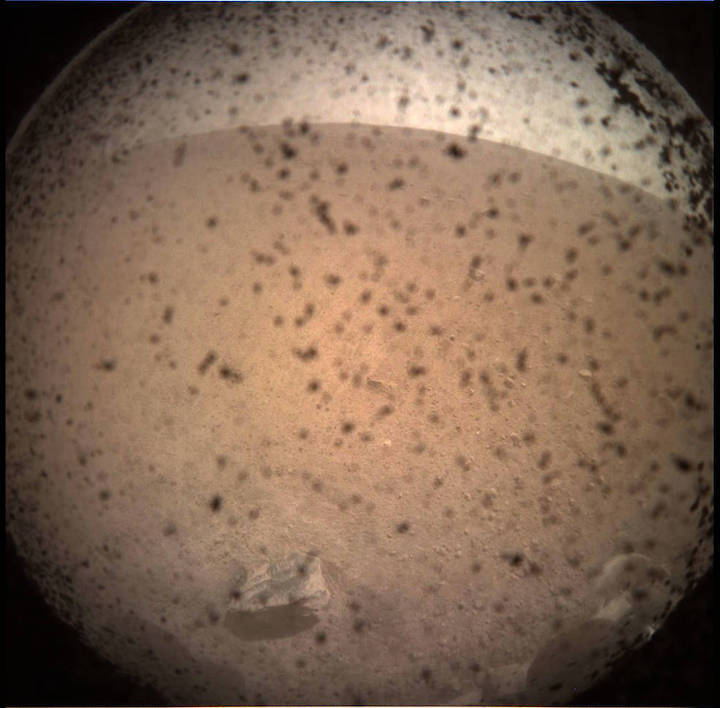
Mars has just received its newest robotic resident. NASA's Interior Exploration using Seismic Investigations, Geodesy and Heat Transport (InSight) lander successfully touched down on the Red Planet after an almost seven-month, 300-million-mile (458-million-kilometer) journey from Earth.
InSight’s two-year mission will be to study the deep interior of Mars to learn how all celestial bodies with rocky surfaces, including Earth and the Moon, formed.
InSight launched from Vandenberg Air Force Base in California May 5. The lander touched down Monday, Nov. 26, near Mars' equator on the western side of a flat, smooth expanse of lava called Elysium Planitia, with a signal affirming a completed landing sequence at approximately noon PST (3 p.m. EST).
"Today, we successfully landed on Mars for the eighth time in human history,” said NASA Administrator Jim Bridenstine. “InSight will study the interior of Mars, and will teach us valuable science as we prepare to send astronauts to the Moon and later to Mars. This accomplishment represents the ingenuity of America and our international partners and it serves as a testament to the dedication and perseverance of our team. The best of NASA is yet to come, and it is coming soon.”
The landing signal was relayed to NASA's Jet Propulsion Laboratory (JPL) in Pasadena, California, via one of NASA's two small experimental Mars Cube One (MarCO) CubeSats, which launched on the same rocket as InSight and followed the lander to Mars. They are the first CubeSats sent into deep space. After successfully carrying out a number of communications and in-flight navigation experiments, the twin MarCOs were set in position to receive transmissions during InSight's entry, descent and landing.
From Fast to Slow
"We hit the Martian atmosphere at 12,300 mph (19,800 kilometers per hour), and the whole sequence to touching down on the surface took only six-and-a-half minutes," said InSight project manager Tom Hoffman at JPL. "During that short span of time, InSight had to autonomously perform dozens of operations and do them flawlessly — and by all indications that is exactly what our spacecraft did."
Confirmation of a successful touchdown is not the end of the challenges of landing on the Red Planet. InSight's surface-operations phase began a minute after touchdown. One of its first tasks is to deploy its two decagonal solar arrays, which will provide power. That process begins 16 minutes after landing and takes another 16 minutes to complete.
The InSight team expects a confirmation later Monday that the spacecraft's solar panels successfully deployed. Verification will come from NASA's Odyssey spacecraft, currently orbiting Mars. That signal is expected to reach InSight's mission control at JPL about five-and-a-half hours after landing.
"We are solar powered, so getting the arrays out and operating is a big deal," said Hoffman. "With the arrays providing the energy we need to start the cool science operations, we are well on our way to thoroughly investigate what's inside of Mars for the very first time."
InSight will begin to collect science data within the first week after landing, though the teams will focus mainly on preparing to set InSight's instruments on the Martian ground. At least two days after touchdown, the engineering team will begin to deploy InSight's 5.9-foot-long (1.8-meter-long) robotic arm so that it can take images of the landscape.
"Landing was thrilling, but I'm looking forward to the drilling," said InSight principal investigator Bruce Banerdt of JPL. "When the first images come down, our engineering and science teams will hit the ground running, beginning to plan where to deploy our science instruments. Within two or three months, the arm will deploy the mission's main science instruments, the Seismic Experiment for Interior Structure (SEIS) and Heat Flow and Physical Properties Package (HP3) instruments."
InSight will operate on the surface for one Martian year, plus 40 Martian days, or sols, until Nov. 24, 2020. The mission objectives of the two small MarCOs which relayed InSight’s telemetry was completed after their Martian flyby.
"That's one giant leap for our intrepid, briefcase-sized robotic explorers," said Joel Krajewski, MarCOproject manager at JPL. "I think CubeSats have a big future beyond Earth's orbit, and the MarCO team is happy to trailblaze the way."
With InSight’s landing at Elysium Planitia, NASA has successfully soft-landed a vehicle on the Red Planet eight times.
"Every Mars landing is daunting, but now with InSight safely on the surface we get to do a unique kind of science on Mars," said JPL director Michael Watkins. "The experimental MarCO CubeSats have also opened a new door to smaller planetary spacecraft. The success of these two unique missions is a tribute to the hundreds of talented engineers and scientists who put their genius and labor into making this a great day."
JPL manages InSight for NASA's Science Mission Directorate. InSight is part of NASA's Discovery Program, managed by the agency's Marshall Space Flight Center in Huntsville, Alabama. The MarCO CubeSats were built and managed by JPL. Lockheed Martin Space in Denver built the InSight spacecraft, including its cruise stage and lander, and supports spacecraft operations for the mission.
A number of European partners, including France's Centre National d'Études Spatiales (CNES) and the German Aerospace Center (DLR), are supporting the InSight mission. CNES, and the Institut de Physique du Globe de Paris (IPGP), provided the SEIS instrument, with significant contributions from the Max Planck Institute for Solar System Research (MPS) in Germany, the Swiss Institute of Technology (ETH) in Switzerland, Imperial College and Oxford University in the United Kingdom, and JPL. DLR provided the HP3 instrument, with significant contributions from the Space Research Center (CBK) of the Polish Academy of Sciences and Astronika in Poland. Spain's Centro de Astrobiología (CAB) supplied the wind sensors.
+++
InSight Is Catching Rays on Mars
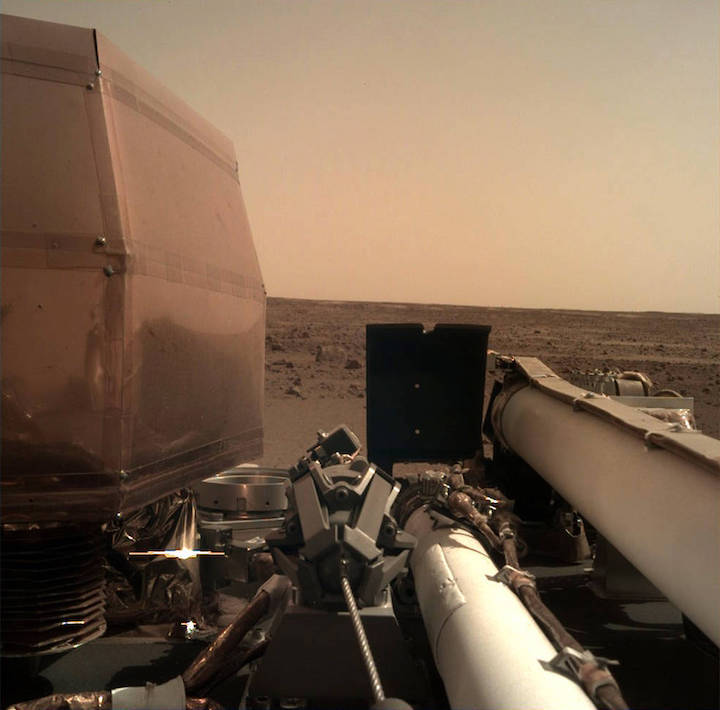
NASA's InSight has sent signals to Earth indicating that its solar panels are open and collecting sunlight on the Martian surface. NASA's Mars Odyssey orbiter relayed the signals, which were received on Earth at about 5:30 p.m. PST (8:30 p.m. EST). Solar array deployment ensures the spacecraft can recharge its batteries each day. Odyssey also relayed a pair of images showing InSight's landing site.
"The InSight team can rest a little easier tonight now that we know the spacecraft solar arrays are deployed and recharging the batteries," said Tom Hoffman, InSight's project manager at NASA's Jet Propulsion Laboratory in Pasadena, California, which leads the mission. "It's been a long day for the team. But tomorrow begins an exciting new chapter for InSight: surface operations and the beginning of the instrument deployment phase."
InSight's twin solar arrays are each 7 feet (2.2 meters) wide; when they're open, the entire lander is about the size of a big 1960s convertible. Mars has weaker sunlight than Earth because it's much farther away from the Sun. But the lander doesn't need much to operate: The panels provide 600 to 700 watts on a clear day, enough to power a household blender and plenty to keep its instruments conducting science on the Red Planet. Even when dust covers the panels — what is likely to be a common occurrence on Mars — they should be able to provide at least 200 to 300 watts.
The panels are modeled on those used with NASA's Phoenix Mars Lander, though InSight’s are slightly larger in order to provide more power output and to increase their structural strength. These changes were necessary to support operations for one full Mars year (two Earth years).
In the coming days, the mission team will unstow InSight's robotic arm and use the attached camera to snap photos of the ground so that engineers can decide where to place the spacecraft's scientific instruments. It will take two to three months before those instruments are fully deployed and sending back data.
In the meantime, InSight will use its weather sensors and magnetometer to take readings from its landing site at Elysium Planitia — its new home on Mars.
About InSight
JPL manages InSight for NASA's Science Mission Directorate. InSight is part of NASA's Discovery Program, managed by the agency's Marshall Space Flight Center in Huntsville, Alabama. Lockheed Martin Space in Denver built the InSight spacecraft, including its cruise stage and lander, and supports spacecraft operations for the mission.
A number of European partners, including France's Centre National d'Études Spatiales (CNES), the Institut de Physique du Globe de Paris (IPGP) and the German Aerospace Center (DLR), are supporting the InSight mission. CNES and IPGP provided the Seismic Experiment for Interior Structure (SEIS) instrument, with significant contributions from the Max Planck Institute for Solar System Research (MPS) in Germany, the Swiss Institute of Technology (ETH) in Switzerland, Imperial College and Oxford University in the United Kingdom, and JPL. DLR provided the Heat Flow and Physical Properties Package (HP3) instrument, with significant contributions from the Space Research Center (CBK) of the Polish Academy of Sciences and Astronika in Poland. Spain’s Centro de Astrobiología (CAB) supplied the wind sensors.
+++
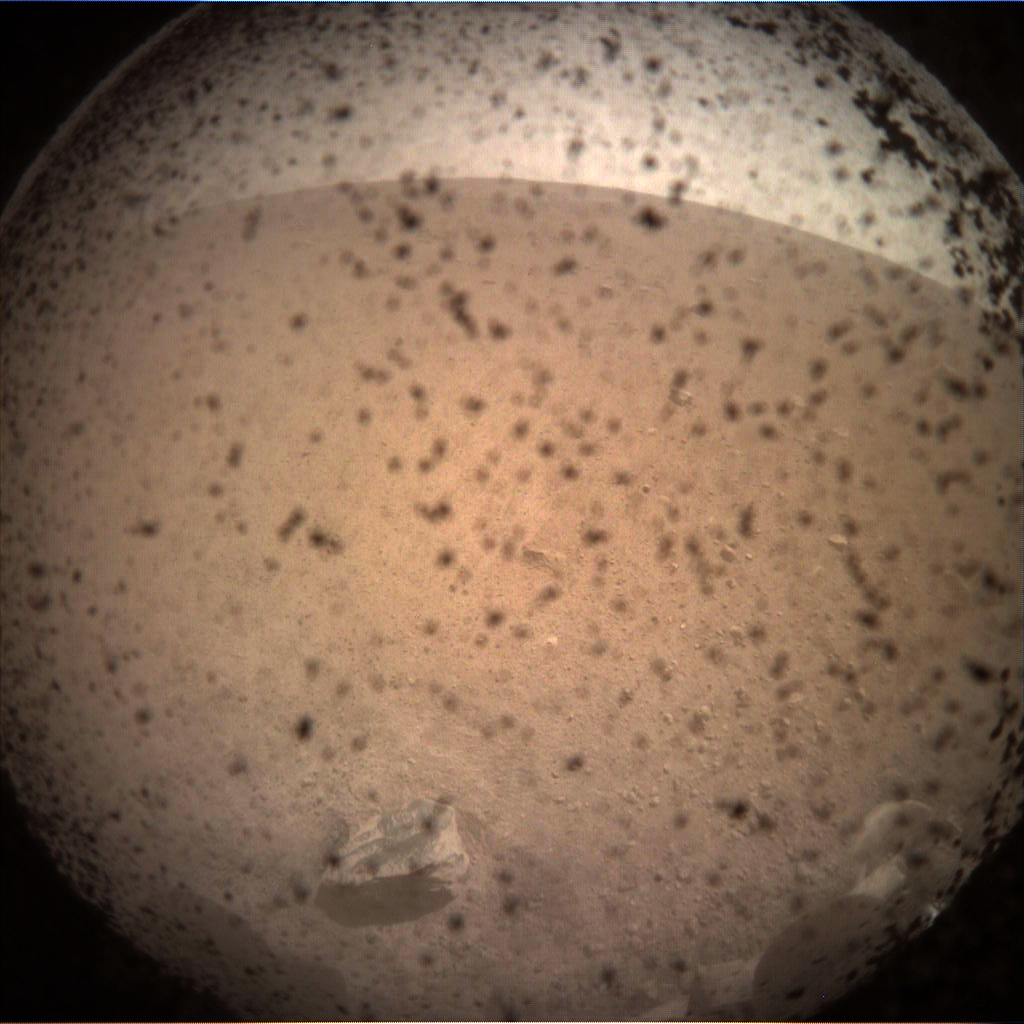
Sol 0: Instrument Context Camera (ICC)
NASA's InSight Mars lander acquired this image of the area in front of the lander using its lander-mounted, Instrument Context Camera (ICC).
This image was acquired on November 26, 2018, Sol 0 of the InSight mission where the local mean solar time for the image exposures was 13:34:21. Each ICC image has a field of view of 124 x 124 degrees.
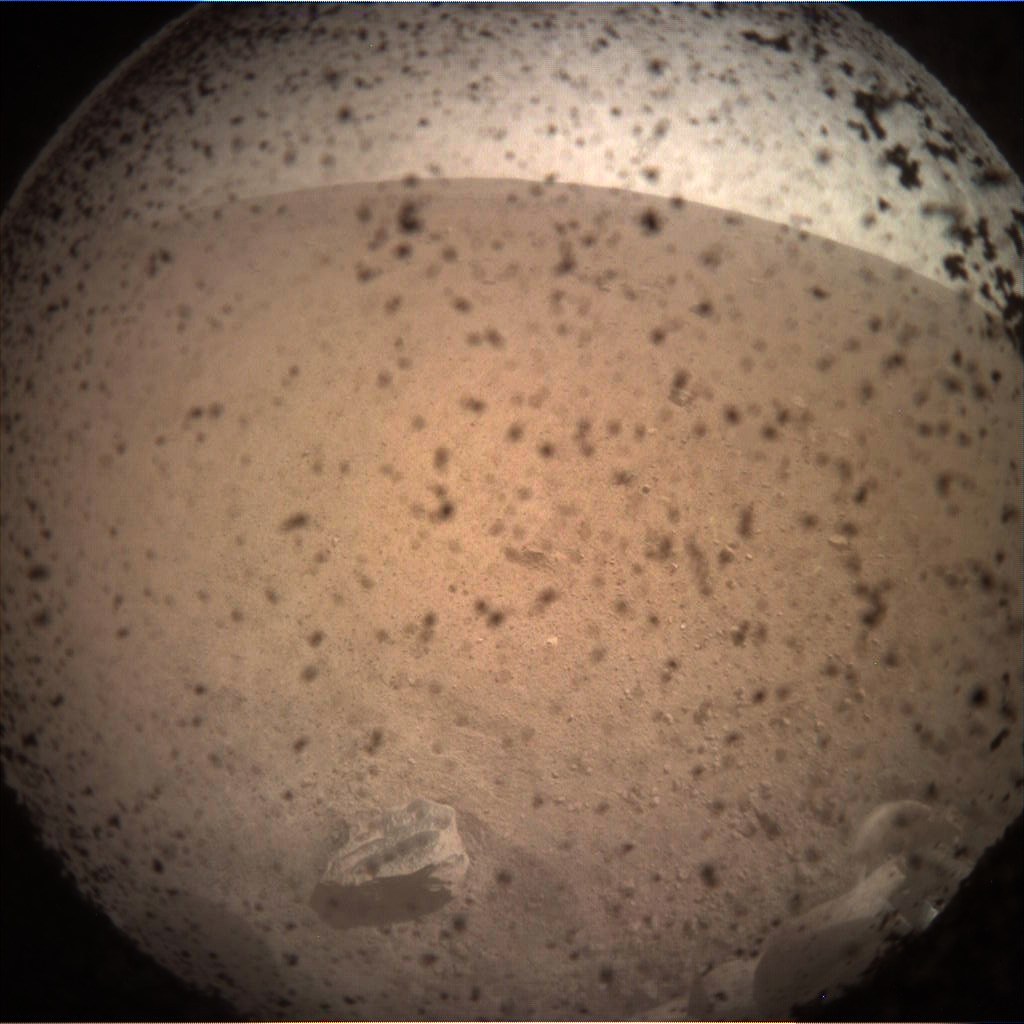
Sol 0: Instrument Context Camera (ICC)
NASA's InSight Mars lander acquired this image of the area in front of the lander using its lander-mounted, Instrument Context Camera (ICC).
This image was acquired on November 26, 2018, Sol 0 of the InSight mission where the local mean solar time for the image exposures was 13:59:31. Each ICC image has a field of view of 124 x 124 degrees.
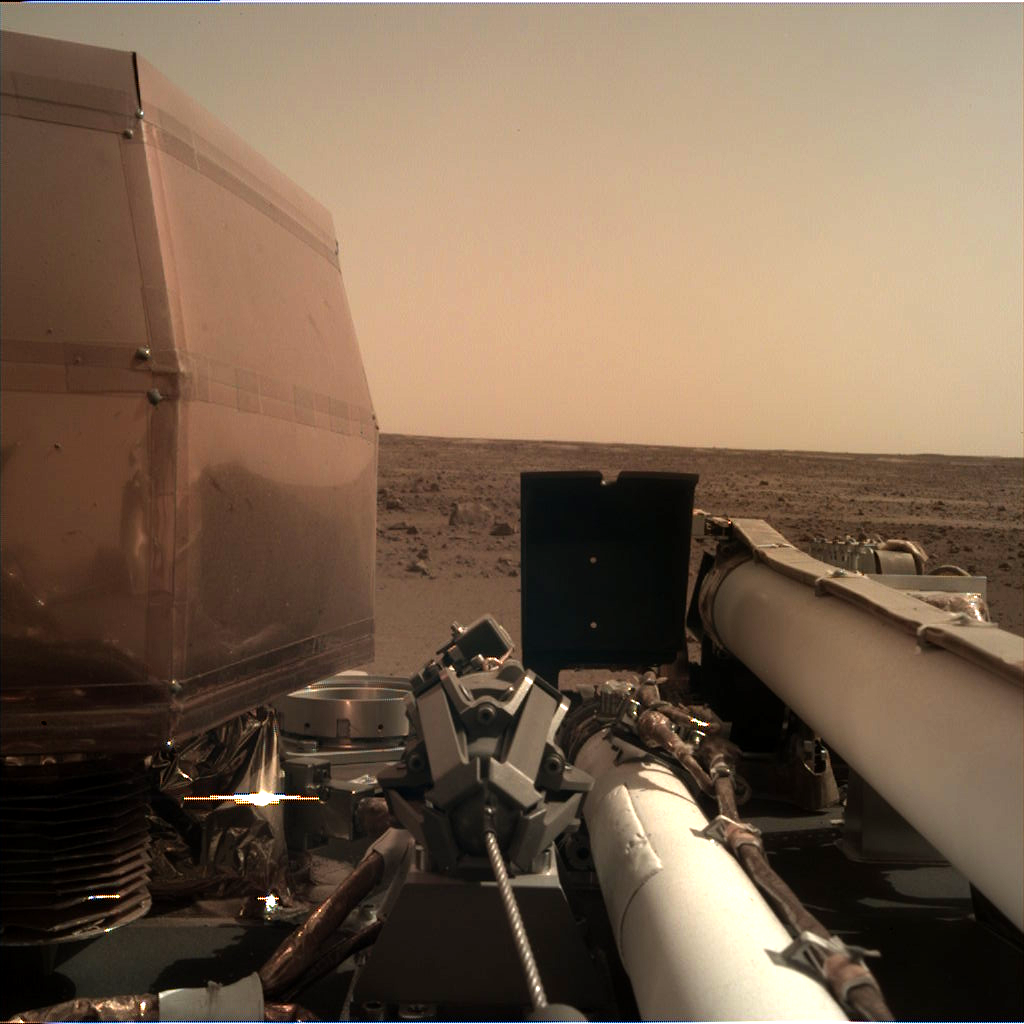
Sol 0: Instrument Deployment Camera (IDC)
NASA's InSight Mars lander acquired this image using its robotic arm-mounted, Instrument Deployment Camera (IDC).
This image was acquired on November 26, 2018, Sol 0 where the local mean solar time for the image exposures was 14:04:35. Each IDC image has a field of view of 45 x 45 degrees.
Quelle: NASA
+++
DENVER, Nov. 26, 2018 /PRNewswire/ -- NASA has a new spacecraft operating on the surface of Mars. This afternoon, the InSight Mars Lander, which was designed, built and tested by Lockheed Martin (NYSE: LMT), navigated the dramatic entry and descent through the Martian atmosphere and touched down on Elysium Planitia in the equatorial region of Mars. Lockheed Martin is the prime contractor responsible for the complete spacecraft system – cruise stage, aeroshell and the lander itself. Mission management and navigation were handled by NASA Jet Propulsion Laboratory (JPL) and spacecraft operations were performed by engineers at Lockheed Martin Space's Mission Support Area in Littleton, Colorado.
At 12:47 p.m. MST, onboard software commands, developed by Lockheed Martin, fired six separation nuts and jettisoned the cruise stage of the spacecraft while it was 78 miles above the surface. That started a series of events that took the spacecraft through six different configurations and from a speed of 12,300 mph to a gentle touchdown on the surface. The data signal confirming the spacecraft had successfully landed was received on Earth at 12:52 p.m. MST.
"The InSight lander is a remarkable spacecraft. Through the entire entry, descent and landing it performed flawlessly," said Stu Spath, InSight program manager and director of Deep Space Exploration at Lockheed Martin Space. "NASA's JPL, which has been a pioneer in Mars exploration for decades, partners with both academia and private industry to bring the best expertise and innovation forward to make important exploration missions like InSight a success."
After landing, the spacecraft waited approximately seven minutes to use its X-band small deep space transponder to send a tone confirming the health of the spacecraft. Then, 25 minutes after that, the lander deployed its two solar arrays, with a width of 19 feet, 8 inches, to begin recharging the spacecraft's batteries
Two NASA orbiters, Mars Reconnaissance Orbiter (MRO) and 2001 Mars Odyssey, were also involved in this historic mission. MRO received and recorded InSight data during its journey to the surface, and will send it back to Earth later today. Both MRO and Odyssey will provide UHF relay during the entirety of the InSight surface mission – Odyssey in the morning and MRO in the afternoon. Both MRO and Odyssey spacecraft were built by Lockheed Martin and both are operated for JPL by the company.
Lockheed Martin has been an industry partner with NASA and the JPL for more than four decades in the exploration of the surface of Mars. Beginning in 1976 with Viking missions, Lockheed Martin has been at the forefront in the development of eleven Mars-bound spacecraft and has played a significant role in all NASA missions to Mars.
"Our team is thrilled by the successful landing of the InSight spacecraft," Lisa Callahan, vice president and general manager of Commercial Civil Space at Lockheed Martin Space. "With missions like this, there are no guarantees; historically, less than half of the world's missions to Mars have been successful. Every arrival at another planet is an incredibly complex engineering challenge. But that's what we do best at Lockheed Martin. It's an honor for us to partner with NASA and JPL on yet another Mars mission."
JPL manages InSight for NASA's Science Mission Directorate. InSight is part of NASA's Discovery Program, managed by the agency's Marshall Space Flight Center in Huntsville, Alabama. Lockheed Martin Space in Denver built the InSight spacecraft, including its cruise stage and lander, and supports spacecraft operations for the mission.
A number of European partners, including France's Centre National d'Études Spatiales (CNES), the Institut de Physique du Globe de Paris (IPGP) and the German Aerospace Center (DLR), are supporting the InSight mission. CNES and IPGP provided the Seismic Experiment for Interior Structure (SEIS) instrument, with significant contributions from the Max Planck Institute for Solar System Research (MPS) in Germany, the Swiss Institute of Technology (ETH) in Switzerland, Imperial College and Oxford University in the United Kingdom, and JPL. DLR provided the Heat Flow and Physical Properties Package (HP3) instrument, with significant contributions from the Space Research Center (CBK) of the Polish Academy of Sciences and Astronika in Poland. Spain's Centro de Astrobiología (CAB) supplied the wind sensors.
Quelle: Lockheed Martin
+++
NASA's InSight lands on Mars with braille 'easter egg' hidden in sight
NASA's InSight, newly arrived on the surface of Mars, will study what cannot be seen — and includes a nod to those without sight.
The robotic lander, which touched down on the Red Planet on Monday (Nov. 26), is equipped with a seismometer and self-hammering "mole" to probe into the deep interior of Mars. The data returned from the U.S.-led international mission will help inform scientists on how worlds such as our own were formed.
As with previous NASA landers and rovers, InSight is adorned with the flags and logos of the countries and space agencies involved in its mission (or at least most of them, more on that below). It is also decorated with a look-and-you-might-miss-it pattern of dots that continues a tradition started by the Jet Propulsion Laboratory (JPL) in Pasadena, California.
"I was thinking what else could we put on there that could be a kind of code that people in the know could look at and figure out?" said Bruce Banerdt, InSight's principal investigator at JPL, in an interview with collectSPACE. "I thought, 'What about braille?'"
Target in sight
InSight's braille "code" can be found on its camera calibration target.
To take precise measurements, InSight will use its robotic arm to deploy its two primary science instruments directly on the surface of Mars. Before it can do so though, it will use a camera mounted on the arm to produce a digital terrain map of its immediate surroundings. Mission managers will then use the imagery to select the best places to deposit the hardware.
"The arm takes a picture and then moves and takes another picture and we create a stereo pair. We then process that to create three-dimensional terrain maps," said imaging scientist Justin Maki, of JPL.
First though, Maki and his team must verify that the camera can produce accurate images after being subjected to the rigors of launch, the nearly seven-month cruise from Earth to Mars and the landing. To do that, InSight is equipped with a calibration target.
Mounted at the rear of InSight's deck is a 7-by-4-inch (17-by-10-centimeter) plate that serves as both the camera's target and the mission's symbolic marker. The lower half of the plate has colored circles, tilted squares (referred to as "slanted edges") and a grayscale gradient scale that will be used to confirm and calibrate the camera's sharpness, contrast and geometry.
"We verify the camera is taking in focus pictures and then we verify the geometry is good to go. Then, at that point, we've checked it out and we can use that to help validate the digital terrain maps," Maki told collectSPACE.
At the top of the calibration target plate, above the circles, are the logos of NASA, CNES (the Centre National d'Études Spatiales, France's national space agency, which provided InSight's seismometer) and DLR (the German Aerospace Center, which built the mission's burrowing heat flow probe). Also displayed are the flags of the United States (twice the size of the others), France, Germany, Switzerland, United Kingdom, Poland, Japan, Austria, Belgium, Spain and Canada.
Italy, which contributed a small laser retroreflector mounted next to the calibration target on InSight's deck, joined the mission after the plate was installed and so its flag is missing from the lander.
Custom code
The target plate, which was made by JPL engineer Jesse Grimes-York, has one more feature: on either side of the flags, logos and calibration tools, are a set of red dots.
"J-P-L" is spelled out in braille, the tactile writing system that is used by the blind and visually impaired.
"JPL has a tradition of trying to put some type of 'easter egg' on its missions," said Banerdt. "One of the rovers [Curiosity] has morse code encoded into the wheels so as it goes through the Martian soil, it leaves behind imprints of 'J-P-L' in code."
"Braille is another kind of a code, an international code that anybody, anywhere in the world could try to interpret. So we tried putting it on there and it looked cool, so we did it," Banerdt told collectSPACE.
The first photographs of the calibration target are expected on Earth within the first week of the mission, pending other engineering checkouts proceeding as planned.
InSight is the second mission to land braille on Mars. On Jan. 25, 2004, NASA's Mars Exploration Rover Opportunity touched down with a mini-DVD decorated in part with a secret message in braille. The disc, which also featured the image of a LEGO astronaut minifigure, was part of a public outreach program organized by The Planetary Society.
"Explore to learn," read the message in braille, as was revealed after photos of the DVD were sent back to Earth.
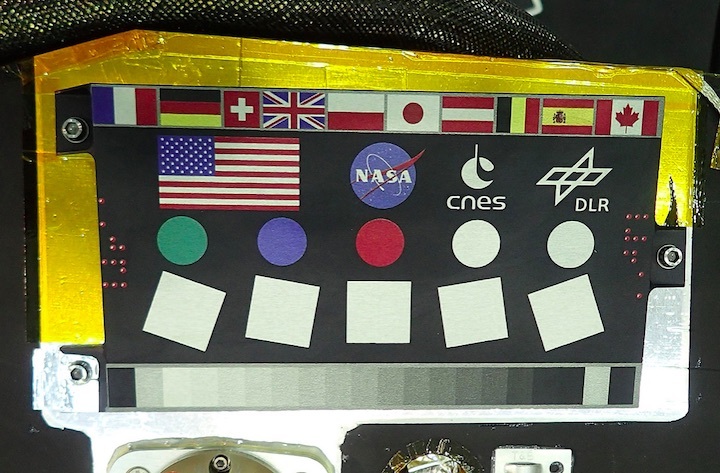
A camera calibration target sits on the deck of the NASA's InSight lander, adorned with the flags of the countries participating in the mission, as well as an "easter egg," a message in coded in braille. (NASA/JPL-Caltech/Lockheed Martin Space)
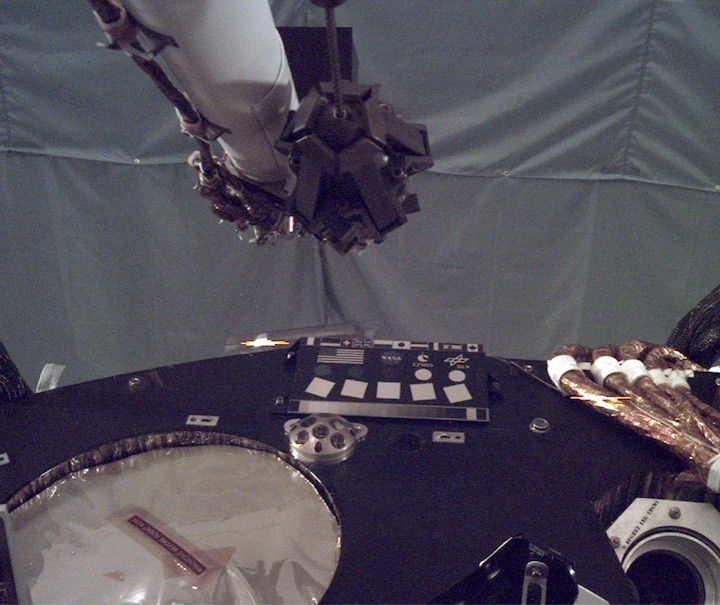
This image of the deck of NASA's InSight lander — where the camera's rectangular calibration target can be seen in the middle — was taken by the Instrument Deployment Camera during the assembly, test and launch operations phase at Lockheed Martin Space, Denver. (NASA/JPL-Caltech/Lockheed Martin Space)
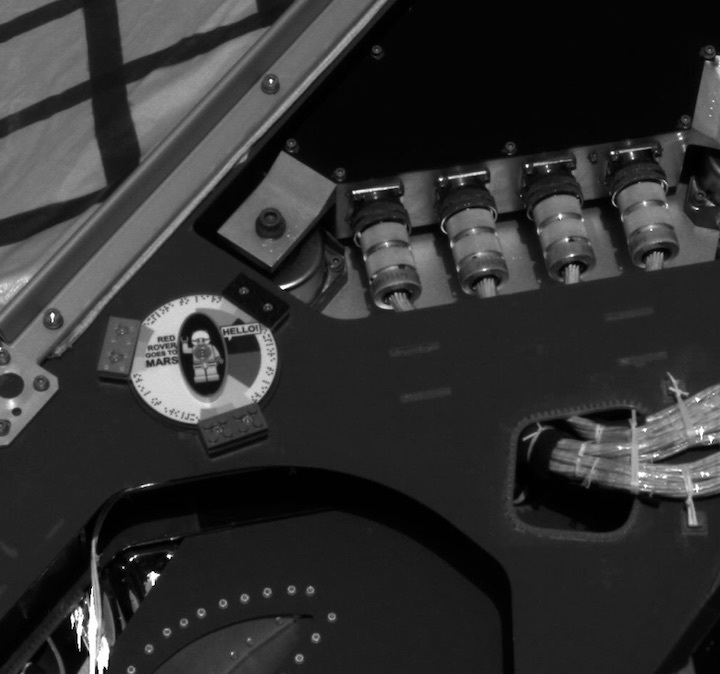
Mars Exploration Rover Opportunity's mini-DVD included a secret message in braille along its edge. (NASA/JPL-Caltech/Cornell/The Planetary Society)

Quelle: CS

